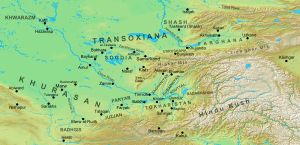Siege of Kamarja
| Siege of Kamarja | |||||||
|---|---|---|---|---|---|---|---|
| Part of the Umayyad-Turgesh Wars and the Muslim conquest of Transoxiana | |||||||
 Map of Khurasan and Transoxiana in the 8th century |
|||||||
|
|||||||
| Belligerents | |||||||
| Umayyad Caliphate |
Turgesh Khaganate Allied Soghdian princes |
||||||
| Commanders and leaders | |||||||
| Unknown | Suluk | ||||||
The Siege of Kamarja was fought in 729 between the Arab Muslims of the Umayyad Caliphate and the Turgesh khaganate, along with its Soghdian allies. The Umayyad conquest of Transoxiana had been undone in the 720s by the uprisings of the local Soghdian princes and the Turgesh invasions. By 729, when the small fortress of Kamarja near Samarkand (in modern Uzbekistan) was one of the last remaining Arab strongholds in Transoxiana, it was attacked by the Turgesh under the personal direction of their ruler, Suluk. The subsequent siege, for which a detailed account survives in the history of al-Tabari, lasted for 58 days and ended with the negotiated withdrawal of its garrison to Samarkand. The stubborn defence of Kamarja was celebrated in Arabic literature, but the Arab hold over the region was broken after the Battle of the Defile two years later. It was only following the collapse of the Turgesh khaganate after 738 that the Arabs re-established their rule over Transoxiana.
The region of Transoxiana (Arabic: Ma wara' al-nahr) had been conquered by the Umayyad leader Qutayba ibn Muslim in the reign of al-Walid I (r. 705–715), following the Muslim conquests of Persia and Khurasan in the mid-7th century. The loyalty to the Caliphate of Transoxiana's native Iranian and Turkic populations and of the autonomous local rulers remained questionable, and in 719 the latter requested aid from the Chinese and their Turgesh vassals. In response, from 720 on the Turgesh launched a series of attacks against the Muslims in Transoxiana, coupled with uprisings against the Caliphate among the local Soghdians. The Umayyad governors initially managed to suppress the unrest, although control over the Ferghana Valley was lost. In 724, governor Muslim ibn Sa'id al-Kilabi and his army suffered a heavy defeat (the so-called "Day of Thirst") at the hands of the Turgesh when he tried to recapture Ferghana. This defeat pushed the Arabs on the defensive, and even though no pitched battles took place, over the next few years the Arab position in Transoxiana collapsed swiftly. By 728, in the face of the Turgesh attacks and a widespread anti-Arab revolt, only Samarkand and the two fortresses of Kamarja and Dabusiyya on the Zarafshan River remained in Arab hands in all of Transoxiana.
...
Wikipedia
